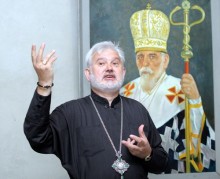Celebrations on the occasion of the consecration of the Patriarchal Cathedral of the Resurrection of Christ began with the exhibitions “Patriarch Josyf Slipyj” and “The Pope and Ukraine” (the latter covers Pope John Paul II’s memorable visit to Kyiv and Lviv in 2001). The organizers hold both exhibitions in the shrine’s crypt (basement). Actually, it is here that the Patriarch will be reburied according to his will. Eyewitnesses recall that his words sounded more like an order than a request, as if the then head of the Greek Catholics knew that Ukraine would become independent. Generally, Slipyj had a very strong intuition. (The Church believes the intuition to be a sign of the Holy Spirit’s strong presence.) Another example was his habit to order large print runs of books, saying that some of them would be needed in Ukraine. He meant, of course, a post-Soviet Ukraine.
Slipyj can be compared with Moses. He strengthened the Ukrainian Greek Catholic Church (UGCC) by rallying its diaspora communities and keeping in touch with the catacomb church in Ukraine, but died just five years before it was able to emerge from the underground.
The exhibition includes rare artifacts ranging from family photos to copies of letters and Patriarch’s personal belongings (a pillow he slept on in exile, glasses, shirt, pajamas). Similarly, the exhibition dedicated to Pope John Paul II includes posters, leaflets, and flags made on the occasion of the Holy Father’s visit to Ukraine (they were once on every corner in Kyiv and Lviv), pictures of the Pope with people and among people... Another photo shows Pope John Paul II paying his respects to deceased Slipyj and kissing his hand. It can be seen as a very strong expression of humanity and resonant political gesture. Thus the pontiff reaffirmed that the church had future and, of course, showed his sympathy. By the way, the photo was printed in Den in 2001 (www.day. kiev.ua/uk/article/cuspilstvo/nihto-ne-kazav-svitovi-stilki-dobrogo-pro-ukrayinu-yak-papa-slovyanin).
“It is no accident that these two figures stand together at this exhibition,” the curator Ruslana Bubriak of the Lviv Museum of the History of Religion said. “They were two Giants, two high-spirited people. I will start with the Patriarch. He met once a famous Austrian painter and poet in Innsbruck, and impressed the artist by saying that the Soviet Empire would collapse sooner or later, and the UGCC would rise again. The Austrian thought, ‘what a naive man,’ and painted Slipyj as Don Quixote, surrounded by the permafrost, in prisoner’s rags and with an ice pick in his hands. We understand now what a gift of prophecy and faith our head of the Church had.
“Now for the Pope,” Bubriak continued. “Ukraine’s ill-wishers said on the eve of his visit to Ukraine that an old frail man would come. A Giant arrived. No matter that his bad legs often forced him to lean on his helpers’ arms. What a high spirit he possessed! Lina Kostenko wrote in her novel Diary of a Ukrainian Madman that when the Pope came down the ramp, the impression was of a white angel descending...”
“I sang for Patriarch Josyf as a five-year-old child during his visit to the Ukrainian community in Britain. (I was born in Nottingham),” Maria Yurkiv-Yarotska from Australia relates, “while my late sister Olha Yurkiv worked in the library of the then UGCC head in Rome. So tears come to my eyes as I walk around and look at the exhibits. Everything is so dear to me. Before Ukraine’s independence, the UGCC was the only barrier to assimilation of Ukrainians in diaspora. By the way, many Greek Catholic parishes in the United States, Canada, and Britain began to switch to English in the liturgy in the 1960s. Church was in shambles as Andrei Sheptytsky died and Slipyj was in exile. Then, Slipyj returned to Rome, rallied the Ukrainian Greek Catholics in the world, and restored the Ukrainian-language liturgy.”
“For me, coming here is a gift of God,” Stefan Tytsky from Sweden concludes, “as the Patriarchal Cathedral of the Resurrection of Christ is the central house of worship for the Ukrainian Greek Catholics around the world. Our head, His Beatitude Sviatoslav (Shevchuk) officiates here. It was Patriarch Josyf and Pope John Paul II who worked for this day to come.”







